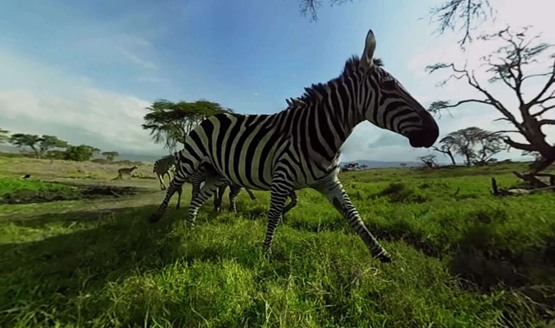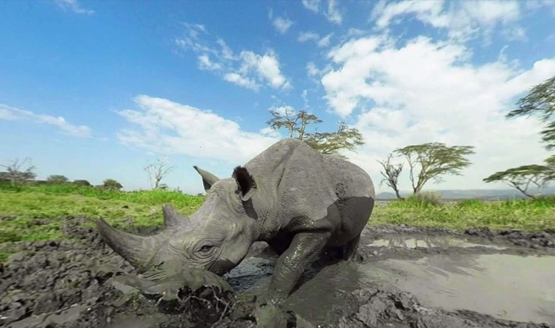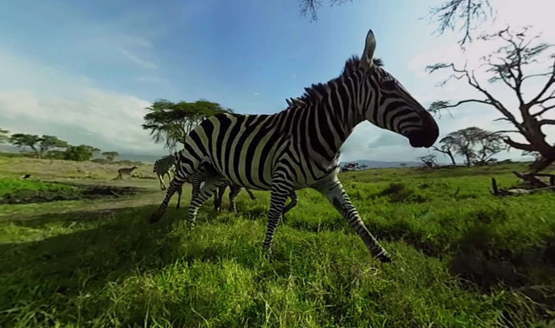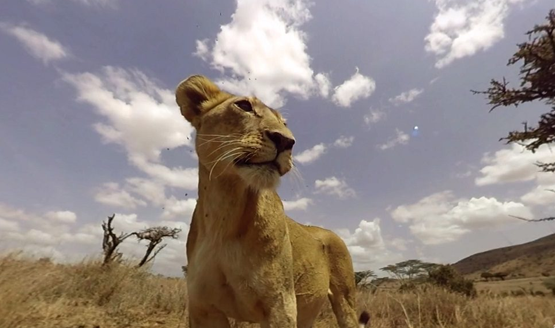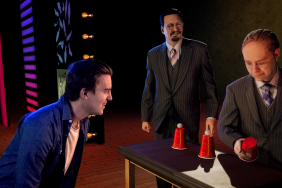Virry may not be the first thing that comes to your mind when you think of PlayStation VR, but it’s an important application of the virtual reality hardware. Virry is a BAFTA-winning wildlife app allows players to interact with wild animals like rhinos, baboons, and giraffes, in a way that no other VR experience does. It doesn’t claim to be a game, but interactive elements do keep the player engaged. The goal of Fountain Digital Labs CEO Dragayeva is to create Zoo 2.0, a new kind of zoo for the technological era.
Svetlana was named one of London’s most influential people of 2016 in Tech, in the Evening Standard. She is one of the leading Tech Female CEOs under 35 with a number of impressive speaking credits as she uses technology to bring awareness to conservationism. Svetlana first spent ten years in film production and then went on to focus her digital knowledge in the education sector by developing the Virry line of products.
Trying to market a more relaxing and educational VR experience in a world full of exciting VR games can be tough. PlayStation gamers may think of VR for gaming applications first and foremost, but there is a whole different side to virtual reality that we need to consider. We had the opportunity to ask Svetlana a few questions about Virry VR and the future of virtual reality as a whole.
PlayStation LifeStyle: What do you see as the state of virtual reality in the industry? Is it continuing growth, or is it a fad that will fade?
Svetlana Dragayeva: I think we’re living in this exciting period when far reaching technologies emerge and develop much faster than our ability to meaningfully digest them. This sometimes causes fading. If you look at the development of 3D cinema, that was quite a thing from the tech point of view, you can see that it is not the technology itself let us down but rather our inability to creatively and meaningfully employ this technology to its full potential. When looking at VR rhetoric, you can see two types of thinking: VR is fading vs VR is just in the beginning of its development. Both stances are true to a certain extent.
VR is fading in the sense of how we first experienced VR: it is not enough to simply give a user an impression of falling anymore. Yet VR is in the beginning of its developmental journey, both technically with standalones coming to the market, i.e. democratizing the market while offering high quality, as well as creatively, conceptualizing on how to better and deeper to engage the user, and in which cases VR as a medium can do this best. Moreover, the more development we see in MR and AR, the more changes we will see in VR.
What is your goal and vision with VR?
For Fountain Digital Labs, every technology available is a tool. It was mobile development yesterday, VR today, MR tomorrow. We creatively employ any tool that helps us better reach our goal, i.e. with the help of technology, to build new emotional, close, and personal connections between humans and nature, between humans and animals, and as a result to trigger a behavioral change in humans. Positive emotional and cognitive immersion into distant wildlife, we hope, makes you more empathic, curious and eco-centric. We believe that VR is a perfect tool for this and we aim at creating experiences that meaningfully use the power of VR. And after all, it’s great fun to be licked by a lioness or feed a critically endangered black baby rhino with your own hands!
There is one more cool side effect of the observation of non-threatening nature: it makes you more relaxed and calm, and as a result you are more capable of solving creative and high-cognitive tasks. Don’t we all want to be effective and creative at work? This is what Virry helps you with too. As a company, we focus on emotional-intellectual edutainment. That is why we are also currently working of a couple of art-related projects that will give you both emotional and intellectual insights. After all, we usually to turn to nature and arts for inspiration, emotional balance, and self-reflection, so why not use technology to enrich our experiences?
How did you get started in the VR space?
It was a natural move from mobile to VR when we asked ourselves just one question: Which technology can currently help us build close and personal relations with distant wild animals? This is how the Virry VR idea was born.
VR has many applications, from simple games to bringing people face-to-face with things that are usually distant. Do you think virtual reality increases connection and empathy with the subject matter?
Although VR was called an empathy machine, I think it is crucial we don’t take empathy for granted. It’s not simply embedded in the technology itself. It’s not a priori there just because you put on a headset. Yet if you do it right, the ‘empathy gate’, as I call it, will open up and offer a user a remarkable journey into their empathic self. And it is the responsibility of content creators to be finding the right keys in every project and to slowly (or better, quickly) develop the ‘VR language’. It took the film industry quite a bit to create the language of film, but now the rules of this language are understood by everyone: you don’t need to be a film studies graduate to know what message a close up of the protagonist means, you know it on a subconscious level already due to the familiarity with the medium and because the use of a close up is derived from human psychology.
Virry is about getting people up close with animals to open hearts and minds about conservation. What else do you think VR has the power to get people close to?
It is not about getting close, it is about ‘why are we getting close?’ VR has a great power to get closer, metaphorically speaking, to yourself and that is of great interest to us.
Do you see yourself expanding beyond Virry and conservation to bring awareness to other causes through VR?
We work with nature and arts because we want humans to be more curious about themselves and the world around them, we want them to be more creative and successful at what they do. In the age when most work will be done by machines quite soon, it seems to us that developing social and emotional intelligence is the key to a happy and balanced life. In our opinion, it’s not about whether you answer emails after 6pm but rather about how effective you are at what you do. We also want people to not only understand on a cognitive level that wild nature needs our protection but to bring it back into our everyday lives to avoid environmental amnesia. There are many causes we are thinking of now too.
Current VR setups are largely seen as being used for gaming. Is this limiting the scope of what virtual reality could be used for? Does it negatively impact apps like Virry that aren’t so much games as they are experiences?
I think that currently you can mostly see the gaming industry and pragmatic industrial applications of VR technology. It naturally does affect Virry and VR is still a very niche product. But we hope that also hardware manufacturers will be more willing to draw attention to Virry not as gaming but rather intellectual entertainment.
Virry allows people to get up close with animals and then use in-app purchases to directly fund conservation efforts, all from their living room. What else would you like to see this ease of donation applied to?
As far as I am aware, Virry VR is the first product that gives you an opportunity to donate through a gamified experience. We thought it was important to explore this approach to small donations to show charities that happy users are willing to donate to their cause.
Virry is currently a 360-degree video without any real 3D mapping (any three-dimensional elements are perceived by the viewer, but the video does not have a three-dimensional space to move around in). Have you considered doing something like the Joshua Bell VR Experience, where they map the video onto modeled 3D objects, allowing for a live recorded video to become an even more immersive virtual reality experience?
If you shoot in 3D, the minimum distance to action is about 1.5m, due to parallax issues. This means that your action can never get into the ‘intimate drama zone’ when the action is right in your face. With a concert violinist, this doesn’t matter. But in Virry VR, the magic moments are when a lion bites the camera, a baboon licks the camera etc. None of these magic moments would exist if we had shot in 3D. It would also be virtually impossible with a natural environment like Virry VR with thousands of moving blades of grass, leaves, trees, etc. to build a 3D virtual model and paste all those elements of the video into it. But of course, we are very much looking forward to tech innovations that will help us build experiences where you can walk around. We are actually working on one right now.
Whats next for you and for Virry? How do you plan on helping the virtual reality market grow?
We are releasing our new product – Virry VR: Wild Encounters on within a few weeks [Editor’s Note: Available now] and hope that the PlayStation VR owners will love it. We are also planning to release Virry: Happy in Nature later in the year. It’s designed to be relaxing, meditative experiences with beautiful sound guided breathing, stunning sunsets and lots of peaceful wild creatures and more. We will also be opening up our first Virry VR experience spaces in the US for kids and adults to learn, have fun and discover wildlife. Stay wild, stay with us!
We’d like to thank Svetlana Dragayeva for taking some time to speak with us about virtual reality, VR, and new ways that the technology can be used.
